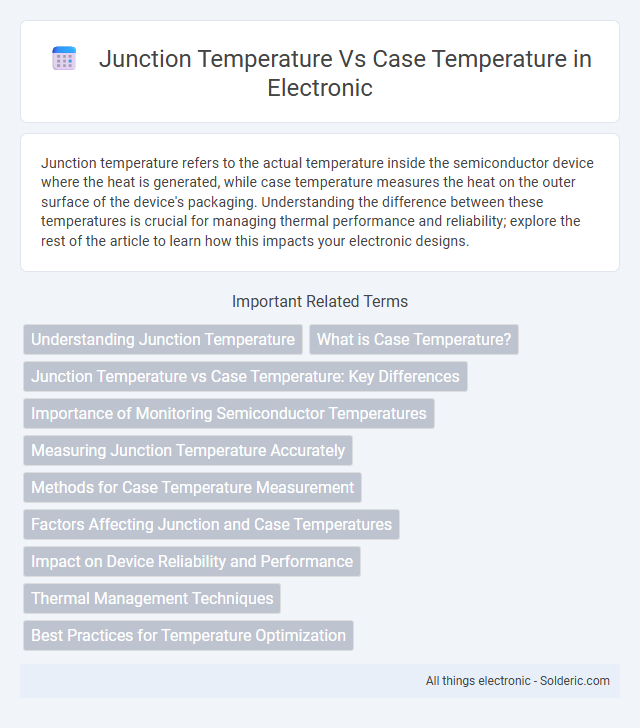Junction temperature refers to the actual temperature inside the semiconductor device where the heat is generated, while case temperature measures the heat on the outer surface of the device's packaging. Understanding the difference between these temperatures is crucial for managing thermal performance and reliability; explore the rest of the article to learn how this impacts your electronic designs.
Comparison Table
| Parameter | Junction Temperature (Tj) | Case Temperature (Tc) |
|---|---|---|
| Definition | Temperature at the semiconductor die inside a device | Temperature at the outer surface of the device package |
| Measurement Point | Inside the semiconductor junction | On the device case or housing |
| Importance | Critical for device performance, reliability, and lifetime | Important for thermal management and cooling design |
| Typical Range | Up to 150degC - 175degC depending on device | Usually lower than junction temperature by 10degC - 30degC |
| Measurement Method | Indirect--calculated using thermal resistance and Tc | Direct--measured with thermocouple or infrared sensor |
| Thermal Resistance Relation | Tj = Tc + (Power x Junction-to-Case Thermal Resistance) | Starting point for calculating junction temperature |
| Use in Datasheets | Maximum allowed junction temperature specified | Maximum case temperature specified for safe operation |
Understanding Junction Temperature
Junction temperature refers to the temperature at the semiconductor die inside an electronic component, critical for assessing device reliability and performance. It is typically higher than the case temperature, which measures the outer surface temperature of the device. Understanding junction temperature helps you prevent overheating and optimize thermal management for effective operation and longevity of electronic components.
What is Case Temperature?
Case temperature refers to the temperature measured at the outer surface of an electronic component, typically where the device is mounted or attached to a heat sink. It provides a practical indication of how effectively heat is being dissipated from the component's internal junction to the external environment. Monitoring your device's case temperature helps ensure reliable performance and prevents thermal damage by offering a safer margin compared to the critical junction temperature.
Junction Temperature vs Case Temperature: Key Differences
Junction temperature refers to the actual temperature of the semiconductor die inside a device, while case temperature measures the outer surface temperature of the device housing. Accurate monitoring of junction temperature is critical for ensuring device reliability and preventing thermal damage, as it directly impacts the performance and lifespan of electronic components. You should prioritize junction temperature in thermal management designs since it provides a more precise indication of the device's internal thermal state compared to case temperature.
Importance of Monitoring Semiconductor Temperatures
Monitoring junction temperature is crucial for maintaining the reliability and performance of semiconductors since it directly reflects the actual operating point of the silicon die. Case temperature provides an external measure for thermal management but does not capture localized hotspots within the device, making it less precise for predicting failure or degradation. Keeping your semiconductor junction temperatures within specified limits prevents thermal runaway, ensures optimal efficiency, and extends the overall lifespan of electronic components.
Measuring Junction Temperature Accurately
Measuring junction temperature accurately involves using methods such as infrared thermography, thermocouples placed close to the die, or silicon-based temperature sensors embedded within semiconductor devices. Junction temperature directly impacts device reliability and performance, making precise measurement critical for thermal management in power electronics and integrated circuits. Case temperature measurement alone can underestimate the true thermal stress since it does not account for heat generated at the semiconductor junction.
Methods for Case Temperature Measurement
Case temperature measurement methods include thermocouples attached directly to the semiconductor package surface, infrared thermography for non-contact temperature sensing, and resistance temperature detectors (RTDs) embedded near the case. These techniques provide accurate readings for thermal management by monitoring heat dissipation paths outside the silicon die. Effective case temperature measurement is critical for evaluating junction temperature indirectly and ensuring device reliability during operation.
Factors Affecting Junction and Case Temperatures
Junction temperature is primarily influenced by the power dissipation within the semiconductor device and the efficiency of heat transfer from the junction to the case, while case temperature depends on the thermal resistance between the case and ambient environment, including heat sink performance and airflow. Materials with high thermal conductivity and proper mounting techniques reduce junction-to-case thermal resistance, directly impacting device reliability and performance. Your ability to manage these factors through optimized cooling solutions and thermal interface materials ensures safe operating temperatures and prolongs component lifespan.
Impact on Device Reliability and Performance
Junction temperature directly affects semiconductor device reliability by accelerating wear mechanisms such as electromigration and impacting carrier mobility, leading to performance degradation over time. Case temperature, while easier to measure, serves as an indirect indicator of junction temperature but can underestimate the thermal stress experienced by the device. To ensure Your device operates reliably and maintains optimal performance, managing junction temperature through effective cooling and thermal design is critical.
Thermal Management Techniques
Effective thermal management techniques for junction temperature focus on enhancing heat dissipation from the semiconductor die through materials with high thermal conductivity, such as copper or aluminum heat sinks. Case temperature management involves improving the thermal interface materials (TIMs) and optimizing package design to minimize thermal resistance between the junction and the case. Advanced cooling solutions, including liquid cooling systems and thermoelectric coolers, are employed to maintain device reliability by controlling both junction and case temperatures within safe operational limits.
Best Practices for Temperature Optimization
Optimizing junction temperature involves precise thermal management techniques, including selecting high-performance heat sinks and ensuring effective thermal interface materials between the semiconductor die and the case. Monitoring case temperature provides measurable data to infer junction temperature, enabling accurate thermal profiling and preventing device overheating. Employing real-time temperature sensors and maintaining efficient airflow enhances heat dissipation, extending device lifespan and improving reliability in electronic components.
Junction temperature vs Case temperature Infographic

 solderic.com
solderic.com